White Grubs In Turf Overview
The larvae of several beetle species, commonly known as White Grubs, are major pests of turfgrass in some parts of Australia. Integrated management programs that include the strategic use of insecticides should be utilised to control Grubs. Merit® is a broad-spectrum insecticide that is effective against White Grubs. Read on to learn more about White Grubs and Envu's available solutions.
Overview
The larvae of several beetle species, commonly known as White Grubs, are major pests of turfgrass in some parts of Australia. Integrated management programs that include the strategic use of insecticides should be utilised to control grubs. Merit® is a broad-spectrum insecticide that is effective against White Grubs.
Soil insecticide performance can be affected by a number of factors including application timing, uniform and accurate application, amount of thatch, rainfall and/or irrigation following treatment, insect species, insect infestation level and dosage. All of these factors must be considered when treating with Merit insecticide to ensure that optimal insect control is achieved.
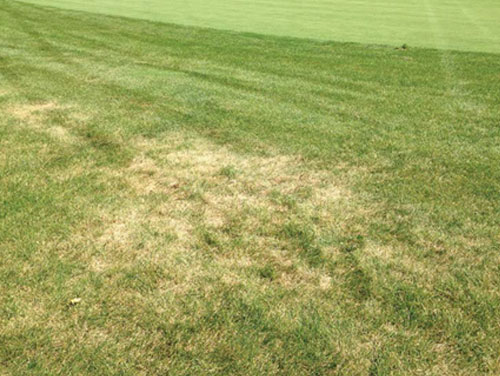 |
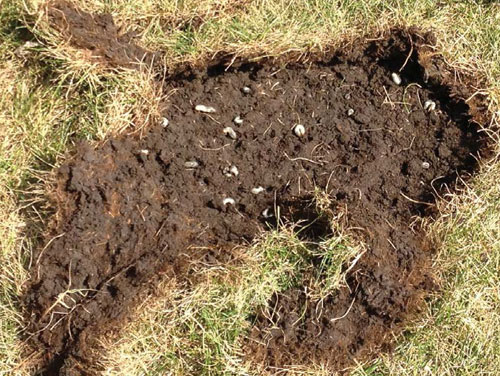 |
The problem
White Grub species include African Black Beetle (Heteronychus Arator), Argentinian Scarab (Cyclocephala Signaticollis), Black-Headed Pasture Cockchafer (Acrossidius Tasmaniae), Red-Headed Pasture Cockchafer (Adoryphorus Couloni) and Pruinose Scarab (Sericesthis Geminata).
Injury to turfgrass occurs from larval feeding on the roots, resulting in infested areas first turning yellow, then brown and finally dying. When grub populations are heavy, areas of turf can be lifted easily from the soil. In addition, birds and vertebrate animals feed on white grubs. Turf can be heavily damaged by the activities of these animals as they forage for grubs in infested turf.
 |
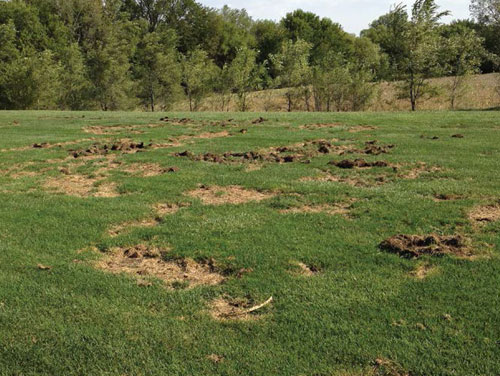 |
What to look for
The adult beetle stage of White Grub differ in size, colour markings and life cycle, while the larval stage is similar in appearance and can be characterised by the C-shaped position when found in the soil-thatch interface area of the turf.
To identify grub larvae, use a 10 X or 20 X hand lens and examine the spines on the underside of the abdomen tip, called the raster. The rastral pattern is different for each grub species and is the most common method of identification. Egg laying can occur at various times during the season depending on species and region of the country but usually continues for four to six weeks. Species like African Black Beetle start in early spring while others like Argentinian Scarab start in mid-summer.
In most cases, adult emergence occurs in mid-summer, often after significant rainfall or irrigation, followed by mating and egg laying. The eggs hatch and the small larvae begin feeding on roots with moulting from first to second instar occurring in a few weeks. Most of the feeding damage is done by the comparatively large third instar larvae and it is this stage that causes visible turf damage. Overwintering occurs in this third instar stage, with larvae moving downward during late March or April into the soil profile for protection from cold weather. The following spring, these larvae will move up to the soil-thatch interface to feed and replenish food reserves lost during the winter months, before moving back down and transforming into the pupal stage. A one-year cycle will be completed with beetles emerging from this pupal stage a short time later.
Monitor beetle activity by establishing black light traps in areas that historically have had grub infestations. Check these traps at two or three day intervals and record and graph collection numbers. Continue trapping until counts start to decline. Larval activity can be expected to occur four to six weeks after peak adult counts
The solution
There are a number of management strategies that must be integrated into a successful grub control program including:
- If renovating or establishing a new turf area, select turf species and varieties more tolerant of grubs.
- Grow healthy turf – implement proper cultural practices including mowing, fertilisation, irrigation and aerification.
- Manage the thatch layer ensuring that there is no more than 12–19 mm of thatch present.
- Properly identify the insect pest and understand its life cycle.
- Select and implement appropriate control strategies.
- If applying an insecticide, make sure to:
- Calibrate application equipment prior to application.
- Under dry conditions where thatch is present, irrigate the area to be treated prior to application. Wetting the thatch/soil interface encourages the larvae to move closer to the surface.
- Irrigate immediately after application. If a complete irrigation cycle is not possible, then syringe immediately and complete irrigation later in the day. No additional irrigation is required if sufficient rainfall to thoroughly wet the thatch and move the product into the soil occurs after application.
- Do not apply to turfgrass soils that are waterlogged or saturated and will not accept irrigation. Adequate distribution of the active ingredient cannot be achieved under these conditions. The treated turf must be in such a condition that the irrigation or rainfall will penetrate vertically into the soil profile.
- Avoid mowing turf until rainfall or irrigation has occurred so that uniformity of application will not be affected.
- Understand that as grub larvae mature from first instar to third instar, they become more difficult to control due to their body size and weight. Therefore, it is crucial to make sure applications are timed properly to optimise insecticide control.
- If the area to be treated experienced high grub populations the previous year and/or was exposed to a mild winter resulting in limited ‘environmental regulation’ of the population, apply the highest label rate of the insecticide.
Technical Information
Preventive control
Merit insecticide is a broad-spectrum, systemic insecticide that is effective at use rates as low as 500 g a.i. per hectare. Imidacloprid, the active ingredient in Merit, interferes with nerve impulses and disrupts insect behaviour, resulting in insects not feeding, not reproducing and eventually dying. Merit is formulated as a suspension concentrate with 200 g/L imidacloprid.
Merit insecticide has sufficient residual activity so that application can be made preceding the egg laying activity of the adult stage. Merit insecticide should be applied to early larval stages of white grubs, which in most areas will mid-spring to early summer.
Optimum control is achieved when applications are made prior to egg hatch of the target pests and when irrigation or rainfall (5–12 mm) occurs within 24 hours of application to move the active ingredient through the thatch into the soil profile.
Apply Merit at 2.5 litres per hectare.
Research data
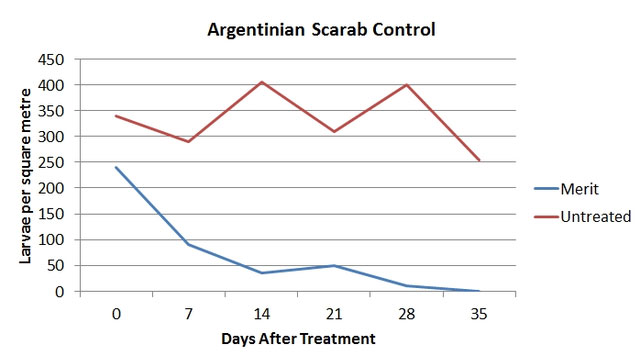 |
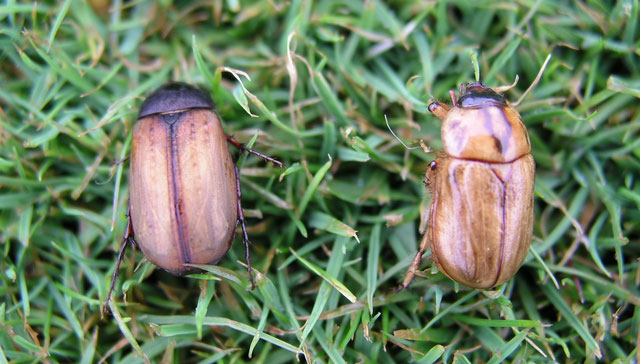 |
| Control of Argentinian scarab with Merit. Graph of treatment with Merit versus untreated, up to five weeks after treatment. | (L) Pruinose scarab, (R) Argentinian scarab. |
Always read the label before use.
Back to Other Insects
